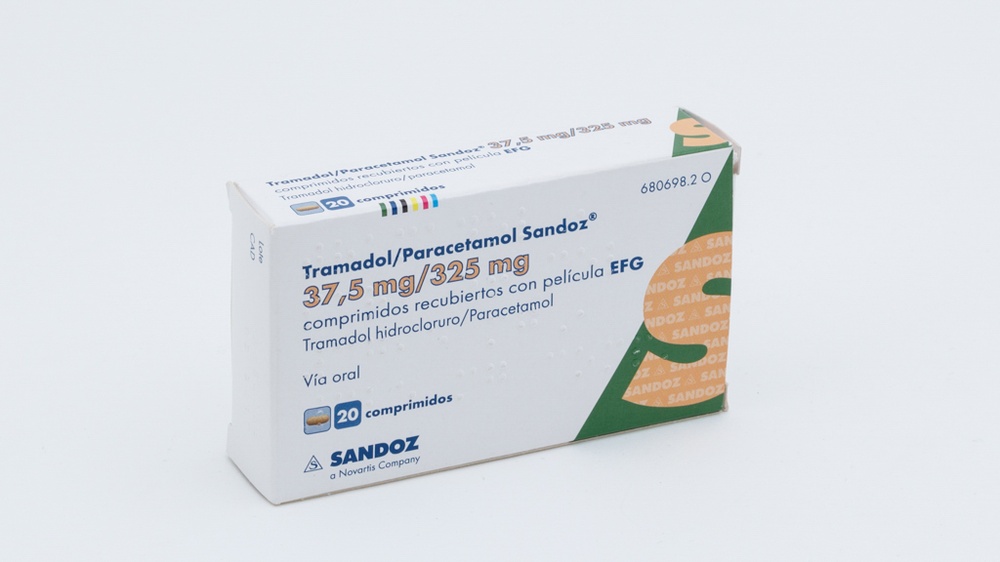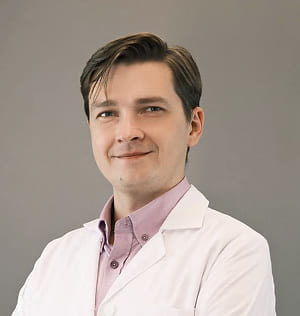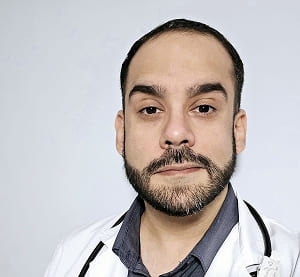

TRAMADOL/PARACETAMOL SANDOZ 37,5 mg/325 mg COMPRIMIDOS REVESTIDOS POR PELÍCULA

Pergunte a um médico sobre a prescrição de TRAMADOL/PARACETAMOL SANDOZ 37,5 mg/325 mg COMPRIMIDOS REVESTIDOS POR PELÍCULA

Como usar TRAMADOL/PARACETAMOL SANDOZ 37,5 mg/325 mg COMPRIMIDOS REVESTIDOS POR PELÍCULA
Introdução
Prospecto: informação para o paciente
Tramadol/Paracetamol Sandoz 37,5 mg/325 mg comprimidos revestidos com película EFG
Tramadol hidrocloruro/paracetamol
Leia todo o prospecto detenidamente antes de começar a tomar este medicamento, porque contém informações importantes para si.
- Conserva este prospecto, porque pode ter que voltar a lê-lo.
- Se tiver alguma dúvida, consulte o seu médico ou farmacêutico.
- Este medicamento foi prescrito apenas para si, e não deve dá-lo a outras pessoas, embora tenham os mesmos sintomas que si, porque pode prejudicá-las.
- Se experimentar efeitos adversos, consulte o seu médico ou farmacêutico, mesmo que se trate de efeitos adversos que não aparecem neste prospecto. Ver seção 4.
Conteúdo do prospecto
- O que é Tramadol/Paracetamol Sandoz e para que se utiliza
- O que necessita saber antes de começar a tomar Tramadol/Paracetamol Sandoz
- Como tomar Tramadol/Paracetamol Sandoz
- Possíveis efeitos adversos
5 Conservação de Tramadol/Paracetamol Sandoz
- Conteúdo do envase e informação adicional
1. O que é Tramadol/Paracetamol Sandoz e para que se utiliza
Tramadol/Paracetamol Sandoz é uma combinação de dois analgésicos, tramadol e paracetamol, que atuam juntos para aliviar a dor.
Tramadol/Paracetamol, está indicado no tratamento sintomático da dor de intensidade moderada a intensa sempre que o seu médico considere que a combinação de tramadol e paracetamol é necessária.
Tramadol/Paracetamol só deve ser utilizado em adultos e adolescentes maiores de 12 anos.
2. O que necessita saber antes de começar a tomar Tramadol/Paracetamol Sandoz
Não tome Tramadol/Paracetamol Sandoz:
- se é alérgico a tramadol, paracetamol ou a algum dos outros componentes deste medicamento (incluídos na seção 6),
- em caso de intoxicação alcoólica aguda, se está tomando medicamentos para dormir, analgésicos potentes ou outros medicamentos psicótropos (medicamentos que podem alterar o humor e as emoções),
- se está tomando medicamentos chamados inibidores da monoaminoxidase (MAO) (certos medicamentos utilizados para tratar a depressão ou a doença de Parkinson), ou se os tomou nos últimos 14 dias antes do tratamento com tramadol/paracetamol,
- se tem uma doença hepática grave,
- se tem epilepsia que não está controlada adequadamente com o seu tratamento atual.
Advertências e precauções
Consulte o seu médico antes de começar a tomar tramadol/paracetamol se:
- está tomando outros medicamentos que contenham paracetamol ou tramadol,
- tem problemas de fígado ou doença hepática ou se nota que os seus olhos ou a sua pele adquirem um tom amarelo. Isso pode ser indicativo de icterícia ou problemas com os ductos biliares,
- tem problemas de rim,
- tem dificuldades respiratórias graves, por exemplo asma ou problemas pulmonares graves,
- tem epilepsia ou já experimentou ataques ou convulsões,
- sofreu recentemente traumatismo craniano, choque ou dores de cabeça intensas associadas a vômitos,
- sofre transtornos de perda de consciência de origem desconhecida (se sente que se vai desmaiar),
- tem dependência de qualquer outro medicamento utilizado para o alívio da dor, por exemplo morfina,
- está tomando outros medicamentos para o tratamento da dor que contenham buprenorfina, nalbufina ou pentazocina,
- vai ser anestesiado. Informe o seu médico ou dentista que está utilizando tramadol/paracetamol,
- sofre depressão e está tomando antidepressivos, posto que alguns podem interagir com o tramadol (ver «Outros medicamentos e Tramadol/Paracetamol Sandoz»). Existe um débil risco de que experimente um síndrome serotoninérgico suscetível de aparecer após ter tomado tramadol em combinação com determinados antidepressivos ou tramadol em monoterapia. Consulte imediatamente com um médico se apresenta algum dos sintomas ligados a este síndrome grave (ver seção 4 «Possíveis efeitos adversos»).
Tolerância, dependência e adicção
Este medicamento contém tramadol que é um medicamento opiáceo. O uso repetido de opiáceos pode fazer com que o medicamento seja menos eficaz (se habitua a ele, o que se conhece como tolerância). O uso repetido de tramadol/paracetamol também pode provocar dependência, abuso e adicção, o que pode dar lugar a uma sobredose potencialmente mortal. O risco destes efeitos secundários pode aumentar com uma dose mais alta e uma maior duração do uso.
A dependência ou a adicção podem fazer com que se sinta que já não controla a quantidade de medicamento que precisa tomar ou a frequência com que deve tomá-lo.
O risco de se tornar dependente ou adicto varia de uma pessoa para outra. Pode ter um maior risco de se tornar dependente ou adicto a tramadol/paracetamol se:
- Si ou alguém da sua família abusou ou foi dependente do álcool, dos medicamentos com receita ou das drogas ilegais («adicção»).
- É fumador.
- Alguma vez teve problemas com o seu estado de ânimo (depressão, ansiedade ou um transtorno de personalidade) ou foi tratado por um psiquiatra por outras doenças mentais.
Se nota algum dos seguintes sinais enquanto toma tramadol/paracetamol, poderia ser um sinal de que se tornou dependente ou adicto:
- Precisa tomar o medicamento durante mais tempo do que o aconselhado pelo seu médico.
- Precisa tomar mais da dose recomendada.
- Utiliza o medicamento por motivos distintos dos prescritos, por exemplo, «para manter a calma» ou «para dormir».
- Tentou repetidamente e sem sucesso deixar ou controlar o uso do medicamento.
- Quando deixa de tomar o medicamento se sente mal, e se sente melhor quando volta a tomá-lo («efeito de abstinência»).
Se observa algum destes sinais, fale com o seu médico para que lhe indique a melhor via de tratamento para si, incluindo quando é apropriado deixar de tomar e como fazer de forma segura (ver seção 3, Se interrompe o tratamento com Tramadol/Paracetamol Sandoz).
Se alguma das situações anteriores lhe aplica ou lhe ocorreu no passado enquanto está tomando tramadol/paracetamol, informe o seu médico. Ele decidirá se deve continuar a tomar este medicamento.
Tramadol é transformado no fígado por uma enzima. Algumas pessoas têm uma variação desta enzima e isso pode afetar cada pessoa de formas diferentes. Em algumas pessoas, é possível que não se consiga um alívio suficiente da dor, enquanto outras pessoas têm mais probabilidades de sofrer efeitos adversos graves. Se nota algum dos seguintes efeitos adversos, deve deixar de tomar este medicamento e consultar um médico imediatamente: respiração lenta ou superficial, confusão, sonolência, pupilas contraídas, mal-estar geral ou vômitos, constipação, falta de apetite.
Informe o seu médico ou farmacêutico se experimenta algum dos seguintes sintomas enquanto toma tramadol/paracetamol:
- Transtornos respiratórios relacionados com o sono: tramadol/paracetamol pode provocar transtornos respiratórios relacionados com o sono, como apneia do sono (pausas na respiração durante o sono) e hipoxemia relacionada com o sono (nível baixo de oxigênio no sangue). Entre os sintomas podem incluir-se pausas na respiração durante o sono, despertares noturnos devidos à falta de ar, dificuldade para manter o sono ou sonolência excessiva durante o dia. Se si ou outra pessoa observa estes sintomas, ponha-se em contacto com o seu médico. Pode ser que o seu médico considere uma redução da dose.
- Fadiga extrema, falta de apetite, dor abdominal grave, náuseas, vômitos ou pressão arterial baixa. Pode ser indicador de insuficiência suprarrenal (níveis baixos de cortisol). Se tem estes sintomas, ponha-se em contacto com o seu médico, que decidirá se precisa tomar suplementos hormonais.
Crianças e adolescentes
O uso de tramadol/paracetamol não é recomendado em crianças menores de 12 anos porque não se estabeleceu a segurança e eficácia neste grupo de idade.
Uso em crianças com problemas respiratórios:
Não se recomenda o uso de tramadol em crianças com problemas respiratórios, pois os sintomas da toxicidade por tramadol podem piorar nestas crianças.
Outros medicamentos e Tramadol/Paracetamol Sandoz
Informe o seu médico ou farmacêutico se está tomando, tomou recentemente ou pode ter que tomar qualquer outro medicamento.
Importante:este medicamento contém paracetamol e tramadol. Informe o seu médico se está tomando qualquer outro medicamento que contenha além de paracetamol ou tramadol hidrocloruro, de forma que não exceda a dose máxima diária.
Não deve tomar tramadol/paracetamol se está tomando inibidores da monoaminoxidase («IMAOs») (ver seção «Não tome Tramadol/Paracetamol Sandoz»).
Não se recomenda tomar tramadol/paracetamol com os seguintes medicamentos:
- carbamazepina (um medicamento normalmente utilizado para tratar a epilepsia ou alguns tipos de dor como ataques de dor intensos na face chamados neuralgias do trigémino),
- buprenorfina, nalbufina ou pentazocina (analgésicos opioides). O alívio da dor pode ser reduzido.
O risco de efeitos adversos aumenta se também está tomando:
- triptanos (para a enxaqueca) ou inibidores seletivos da recaptação de serotonina, «ISRSs» (para a depressão). Se experimenta confusão, agitação, febre, suor, movimentos não coordenados das extremidades ou dos olhos, contrações incontroláveis dos músculos ou diarreia, deve chamar o seu médico,
- medicamentos sedantes como benzodiazepinas ou medicamentos relacionados (tranquilizantes, medicamentos para dormir). O uso concomitante de tramadol/paracetamol e medicamentos sedantes como benzodiazepinas ou medicamentos relacionados aumenta o risco de sonolência, dificuldades respiratórias (depressão respiratória), coma e pode ser potencialmente mortal. Por este motivo, só se deve considerar o uso concomitante quando não sejam possíveis outras opções de tratamento. No entanto, se o seu médico lhe prescreve este medicamento com medicamentos sedantes, deve limitar a dose e a duração do tratamento concomitante. Informe o seu médico de todos os medicamentos sedantes que está tomando e siga de forma rigorosa a recomendação de dose do seu médico. Pode ser útil informar os seus amigos e familiares sobre os sinais e sintomas indicados anteriormente. Informe o seu médico se experimenta algum destes sintomas.
- outros analgésicos como morfina ou codeína (também utilizado para tratar a tos), baclofeno (relaxante muscular), medicamentos para diminuir a pressão arterial ou medicamentos para o tratamento de alergias. Pode se sentir sonolento ou mareado. Se isso ocorre, consulte com o seu médico,
- medicamentos que podem provocar convulsões (ataques) como certos antidepressivos ou antipsicóticos. O risco de ter um ataque pode aumentar se toma tramadol/paracetamol ao mesmo tempo. O seu médico lhe dirá se tramadol/paracetamol é adequado para si,
- certos medicamentos antidepressivos. Tramadol/paracetamol pode interagir com estes medicamentos e pode experimentar um síndrome serotoninérgico (ver a seção 4 «Possíveis efeitos adversos»).
- warfarina ou fenprocumona (medicamento utilizado para prevenir coágulos no sangue). A eficácia destes medicamentos pode ser alterada e podem ocorrer sangramentos. Deve informar o seu médico imediatamente de qualquer hemorragia prolongada ou inesperada,
- flucloxacilina (antibiótico), devido a um risco grave de alteração do sangue e dos fluidos (acidose metabólica com alto desequilíbrio aniônico) que deve ser tratada urgentemente e que pode ocorrer particularmente em caso de insuficiência renal grave, sepsis (quando as bactérias e suas toxinas circulam no sangue que dá lugar a dano de órgãos), desnutrição, alcoolismo crônico e se utilizam as doses máximas diárias de paracetamol.
- Gabapentina ou pregabalina para tratar a epilepsia ou a dor devido a problemas nervosos (dor neuropática).
A eficácia de tramadol/paracetamol pode ser alterada se também está tomando algum dos seguintes medicamentos:
- metoclopramida, domperidona ou ondansetrão (medicamentos utilizados para tratar náuseas e vômitos),
- colestiramina (medicamento que reduz o colesterol no sangue).
O seu médico lhe dirá quais são os medicamentos seguros para tomar junto com tramadol/paracetamol.
Uso de Tramadol/Paracetamol Sandoz com álcool
Tramadol/Paracetamol Sandoz pode fazer com que se sinta sonolento. O álcool pode fazer com que se sinta sonolento, por isso se recomenda não tomar álcool enquanto estiver tomando Tramadol/Paracetamol Sandoz.
Gravidez e lactação
Se está grávida ou em período de lactação, acredita que possa estar grávida ou tem intenção de ficar grávida, consulte o seu médico ou farmacêutico antes de utilizar este medicamento.
Devido a que este medicamento contém tramadol, não deve tomar este medicamento durante a gravidez. Se ficar grávida durante o tratamento com Tramadol/Paracetamol Sandoz, consulte o seu médico antes de tomar mais comprimidos.
O tramadol é excretado no leite materno. Por este motivo, não deve tomar tramadol/paracetamol mais de uma vez durante a lactação, ou, se tomar tramadol/paracetamol mais de uma vez, deve interromper a lactação.
Condução e uso de máquinas
Tramadol/Paracetamol Sandoz pode fazer com que se sinta sonolento e isso pode afetar a sua capacidade para conduzir ou usar ferramentas e máquinas de forma segura.
Tramadol/Paracetamol Sandoz contém sódio
Este medicamento contém menos de 1 mmol de sódio (23 mg) por comprimido revestido com película; isto é, essencialmente «exento de sódio».
3. Como tomar Tramadol/Paracetamol Sandoz
Siga exatamente as instruções de administração deste medicamento indicadas pelo seu médico ou farmacêutico. Em caso de dúvida, consulte novamente o seu médico ou farmacêutico.
Antes de iniciar o tratamento e de forma regular durante o mesmo, o seu médico lhe explicará o que pode esperar do uso de tramadol/paracetamol, quando e durante quanto tempo deve tomá-lo, quando deve entrar em contacto com o seu médico e quando deve interromper (ver também seção 2).
Deve tomar tramadol/paracetamol durante o menor tempo possível.
Deve ajustar a dose à intensidade da dor e à sensibilidade de cada paciente. Geralmente deve selecionar a menor dose eficaz que produza analgesia.
Uso em adultos e adolescentes (a partir de 12 anos)
A menos que o seu médico lhe prescreva algo distinto, a dose recomendada de início é de 2 comprimidos.
Se for necessário, podem ser tomadas mais doses, tal como lhe recomende o seu médico. O intervalo mais curto entre doses deve ser de pelo menos 6 horas.
Não tome mais de 8 comprimidos de Tramadol/Paracetamol Sandoz ao dia.
Não tome tramadol/paracetamol mais frequentemente do que o que lhe indicou o seu médico.
Se estima que o efeito de tramadol/paracetamol é demasiado forte (ex.: se sente muito sonolento ou tem dificuldade para respirar) ou demasiado débil (ex.: não tem um alívio adequado da dor), comunique ao seu médico.
Pacientes de idade avançada
Em pacientes de idade avançada (maiores de 75 anos) a excreção de tramadol pode ser retardada. Se isso lhe suceder, o seu médico pode recomendar um intervalo de dose prolongado.
Doença grave do fígado ou dos rins (insuficiência)/pacientes em diálise
Os pacientes com insuficiência hepática e/ou renal grave não devem tomar tramadol/paracetamol. Se no seu caso a insuficiência for de leve a moderada, o seu médico pode recomendar uma prolongação do intervalo entre doses.
Forma de administração:
Os comprimidos são para administração por via oral.
Engula os comprimidos inteiros com suficiente líquido. Não os deve partir nem mastigar.
Se tomar mais Tramadol/Paracetamol Sandoz do que deve
Consulte imediatamente o seu médico ou farmacêutico, embora se sinta bem, porque existe o risco de que se produzam danos graves no fígado que só se pondrán de manifesto mais tarde.
Em caso de sobredose ou ingestão acidental, consulte imediatamente o seu médico ou farmacêutico ou ligue para o Serviço de Informação Toxicológica, telefone: 91 562 04 20, indicando o medicamento e a quantidade ingerida.
Se esquecer de tomar Tramadol/Paracetamol Sandoz
Se esquecer de tomar os comprimidos, é provável que a dor reapareça. Não tome uma dose dupla para compensar a dose esquecida, simplesmente continue tomando os comprimidos como de costume.
Se interromper o tratamento com Tramadol/Paracetamol Sandoz
Não deve deixar de tomar de repente este medicamento a menos que o seu médico lhe indique. Se deseja deixar de tomar o seu medicamento, fale primeiro com o seu médico, especialmente se o tem estado tomando durante muito tempo. O seu médico lhe informará quando e como interromper, o que pode fazer reduzindo a dose gradualmente para reduzir a probabilidade de sofrer efeitos adversos desnecessários (sintomas de abstinência) (ver seção 4. «Possíveis efeitos adversos»).
Se tiver alguma outra dúvida sobre o uso deste medicamento, pergunte ao seu médico ou farmacêutico.
4. Possíveis efeitos adversos
Tal como todos os medicamentos, este medicamento pode produzir efeitos adversos, embora nem todas as pessoas os sofram.
Alguns efeitos adversos podem ser graves. Contacte o seu médico imediatamente se lhe ocorrer algum dos seguintes:
- casos raros de erupção cutânea, indicando uma reação alérgica, pode desenvolver-se uma inchação da face, língua ou garganta, dificuldade para respirar ou diminuição da pressão arterial e desmaios. Se lhe ocorrer isto, interrompa o tratamento. Não volte a tomar este medicamento,
- sangramento prolongado ou inesperado, devido ao uso de tramadol/paracetamol com medicamentos utilizados para diluir a sangue (ex: warfarina, fenprocumona).
Adicionalmente, se algum dos seguintes efeitos adversos se agravar, contacte o seu médico ou farmacêutico:
Muito frequentes:podem afetar mais de 1 de cada 10 pessoas:
- náuseas,
- tonturas, sonolência.
Frequentes:podem afetar até 1 de cada 10 pessoas
- vómitos, problemas digestivos (constipação, flatulência, diarreia), dor de estômago, secura da boca,
- coceira, suor,
- dor de cabeça, agitação,
- confusão, distúrbios do sono, mudanças de humor (ansiedade, nervosismo, euforia - sensação de se sentir com o ânimo alto).
Pouco frequentes:podem afetar até 1 de cada 100 pessoas
- aumento no pulso ou na pressão sanguínea, distúrbios da frequência cardíaca ou do ritmo cardíaco,
- dificuldade ou dor ao urinar,
- reações da pele (por exemplo, erupções cutâneas, urticárias),
- formigamento, entorpecimento ou sensação de formigamento nas extremidades, ruídos no ouvido, espasmos musculares involuntários,
- depressão, pesadelos, alucinações (ouvir, ver ou perceber algo que não existe na realidade), perda de memória,
- dificuldade para engolir, sangue nas fezes,
- arrepios, ondas de calor, dor no peito,
- dificuldade para respirar,
- aumento nas enzimas do fígado (transaminases hepáticas), perda de certas proteínas com a urina (albumina).
Raros:podem afetar até 1 de cada 1.000 pessoas
- convulsões, dificuldades para realizar movimentos coordenados,
- dependência, delírio,
- visão turva, contração da pupila (miose), dilatação excessiva das pupilas (midriase),
- distúrbios da fala,
- perda transitória da consciência (síncope).
Frequência desconhecida:não pode ser estimada a partir dos dados disponíveis
- síndrome serotoninérgica, que pode manifestar-se através de mudanças do estado mental (por exemplo, agitação, alucinações, coma), e outros efeitos, como febre, aumento da frequência cardíaca, pressão arterial instável, contrações musculares involuntárias, rigidez muscular, falta de coordenação e/ou sintomas gastrointestinais (por exemplo, náuseas, vómitos, diarreia) (veja seção 2 «o que precisa saber antes de tomar Tramadol/Paracetamol Sandoz).
- diminuição do nível de açúcar no sangue,
- hipo.
Além disso, os seguintes efeitos adversos reconhecidos foram notificados por pessoas que tomaram medicamentos que continham apenas tramadol ou apenas paracetamol. No entanto, se experimentar algum desses sintomas enquanto toma tramadol/paracetamol, deve informar o seu médico:
- sensação de tontura ao levantar-se após estar deitado ou sentado, baixa frequência cardíaca, desmaio,
- mudanças no apetite,
- fraqueza muscular, respiração mais lenta ou mais fraca,
- mudanças de humor, mudanças de atividade (geralmente diminuindo, ocasionalmente aumentando), mudanças na percepção,
- agravamento do asma existente,
- hemorragias nasais ou sangramento das gengivas, que podem resultar de um recuento baixo de plaquetas,
- redução severa no número de glóbulos brancos, que torna mais provável que as infecções tenham possíveis sinais de febre e dor de garganta (agranulocitose).
Usar um medicamento como tramadol pode criar dependência, tornando difícil parar de tomá-lo. Pessoas que têm tomado tramadol por algum tempo podem se sentir mal quando interrompem o tratamento bruscamente. Podem se sentir agitadas, ansiosas, nervosas ou trêmulas. Podem estar hiperativas, ter dificuldade para dormir e apresentar distúrbios digestivos e intestinais. Muito pouca gente pode ter também ataques de pânico, alucinações, percepções incomuns como coceira, sensação de formigamento e entorpecimento, e ruídos nos ouvidos (zumbido). Se você experimentar algum desses sintomas após interromper o tratamento com tramadol/paracetamol, consulte o seu médico.
O uso de tramadol/paracetamol junto com anticoagulantes (p. ex.: fenprocumona, warfarina) pode aumentar o risco de hemorragias. Deve informar o seu médico imediatamente sobre qualquer hemorragia prolongada ou inesperada.
Foram comunicados casos muito raros de reações graves da pele.
Comunicação de efeitos adversos
Se experimentar qualquer tipo de efeito adverso, consulte o seu médico ou farmacêutico, mesmo que se trate de possíveis efeitos adversos que não aparecem neste prospecto. Também pode comunicá-los diretamente através do Sistema Espanhol de Farmacovigilância de Medicamentos de Uso Humano: https://www.notificaram.es. Mediante a comunicação de efeitos adversos, você pode contribuir para fornecer mais informações sobre a segurança deste medicamento.
5. Conservação de Tramadol/Paracetamol Sandoz
Mantenha este medicamento fora da vista e do alcance das crianças.
Guarde este medicamento em um local seguro e protegido, onde outras pessoas não possam acessá-lo. Pode causar danos graves e ser mortal para as pessoas a quem não foi prescrito.
Não use este medicamento após a data de validade que aparece no envase de cartão, o blister ou envase após CAD. A data de validade é o último dia do mês que é indicado.
Após a primeira abertura do envase, este medicamento pode ser administrado durante 50 dias se for conservado entre 15°C – 30°C.
Este medicamento não requer condições especiais de conservação.
Os medicamentos não devem ser jogados nos deságues ou na lixeira. Deposite os envases e os medicamentos que não precisa no Ponto SIGRE da farmácia. Em caso de dúvida, pergunte ao seu farmacêutico como se livrar dos envases e dos medicamentos que não precisa. Dessa forma, você ajudará a proteger o meio ambiente.
6. Conteúdo do envase e informação adicional
Composição de Tramadol/Paracetamol Sandoz
- Os princípios ativos são tramadol hidrocloruro e paracetamol.
Cada comprimido revestido com película contém 37,5 mg de tramadol hidrocloruro e 325 mg de paracetamol.
- Os demais componentes são:
Núcleo do comprimido: copolímero de macrogol polivinil álcool, amido de milho pregelatinizado, celulose microcristalina, carboximetilamido sódico (Tipo A) de batata, hiprolosa, estearato de magnésio.
Película de revestimento: álcool polivinílico, dióxido de titânio (E 171), macrogol, talco, óxido de ferro amarelo (E 172), óxido de ferro vermelho (E 172), óxido de ferro preto (E 172).
Aspecto do produto e conteúdo do envase
Tramadol/Paracetamol Sandoz comprimidos revestidos com película são de cor melocotão, com forma de cápsula, gravado com T37.5 em uma face e A325 por outra face.
Tramadol/Paracetamol Sandoz é apresentado em envases de cartão com blisters de 2, 10, 15, 20, 30, 40, 60, 80 e 90 comprimidos e frascos com 10 e 100 comprimidos.
Pode ser que apenas alguns tamanhos de envases sejam comercializados.
Titular da autorização de comercialização e responsável pela fabricação
Titular da autorização de comercialização
Sandoz Farmacêutica, S.A
Centro Empresarial Parque Norte
Edifício Roble
C/ Serrano Galvache, 56
28033 Madrid
Espanha
Responsável pela fabricação
Teva Pharma, S.L.U.
C/ C, n 4 Polígono Industrial Malpica (Zaragoza) – 50016
Espanha
ou
Lek Pharmaceuticals d.d.
Verovskova 57, 1526 Ljubljana
Eslovênia
ou
Pliva Hrvatska D.O.O.
Prilaz Baruna Filipovica 25 (ZAGREB) – 10000
Croácia
Este medicamento está autorizado nos Estados-Membros com os seguintes nomes:
República Checa: Tutus 37,5 mg/325 mg
Portugal: Tramadol + Paracetamol Sandoz
Data da última revisão deste prospecto:abril 2025
A informação detalhada deste medicamento está disponível na página web da Agência Espanhola de Medicamentos e Produtos Sanitários (AEMPS) http://www.aemps.gob.es

Quanto custa o TRAMADOL/PARACETAMOL SANDOZ 37,5 mg/325 mg COMPRIMIDOS REVESTIDOS POR PELÍCULA em Espanha em 2025?
O preço médio do TRAMADOL/PARACETAMOL SANDOZ 37,5 mg/325 mg COMPRIMIDOS REVESTIDOS POR PELÍCULA em dezembro de 2025 é de cerca de 2.97 EUR. Os valores podem variar consoante a região, a farmácia e a necessidade de receita. Confirme sempre com uma farmácia local ou fonte online para obter informações atualizadas.
- País de registo
- Preço médio em farmácia2.97 EUR
- Substância ativa
- Requer receita médicaSim
- Fabricante
- Esta informação é apenas para referência e não constitui aconselhamento médico. Consulte sempre um médico antes de tomar qualquer medicamento. A Oladoctor não se responsabiliza por decisões médicas baseadas neste conteúdo.
- Alternativas a TRAMADOL/PARACETAMOL SANDOZ 37,5 mg/325 mg COMPRIMIDOS REVESTIDOS POR PELÍCULAForma farmacêutica: COMPRIMIDO, 325/37,5 mgSubstância ativa: tramadol and paracetamolFabricante: Ferrer Internacional S.A.Requer receita médicaForma farmacêutica: COMPRIMIDO, 650/75 mgSubstância ativa: tramadol and paracetamolFabricante: Ferrer Internacional S.A.Requer receita médicaForma farmacêutica: COMPRIMIDO EFERVESCENTE, 37,5 mg/325 mgSubstância ativa: tramadol and paracetamolFabricante: Aristo Pharma Iberia S.L.Requer receita médica
Alternativas a TRAMADOL/PARACETAMOL SANDOZ 37,5 mg/325 mg COMPRIMIDOS REVESTIDOS POR PELÍCULA noutros países
As melhores alternativas com o mesmo princípio ativo e efeito terapêutico.
Alternativa a TRAMADOL/PARACETAMOL SANDOZ 37,5 mg/325 mg COMPRIMIDOS REVESTIDOS POR PELÍCULA em Polonia
Médicos online para TRAMADOL/PARACETAMOL SANDOZ 37,5 mg/325 mg COMPRIMIDOS REVESTIDOS POR PELÍCULA
Avaliação de posologia, efeitos secundários, interações, contraindicações e renovação da receita de TRAMADOL/PARACETAMOL SANDOZ 37,5 mg/325 mg COMPRIMIDOS REVESTIDOS POR PELÍCULA – sujeita a avaliação médica e regras locais.














